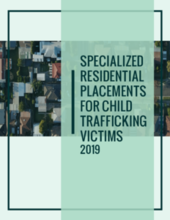Executive Summary
As the response to youth who are victims of sex and labor trafficking has become more comprehensive, there is an increased need to provide specialized programming for these youth within residential placement settings. Across the country child welfare programs and agencies providing services for youth at risk for sex and labor trafficking are adopting new strategies to meet the needs of these youth in a variety of settings. This study outlines the policies, practices, and programming that have been implemented across the US to provide specialized responses to exploited and trafficked youth within residential placement settings.
Although there is not currently sufficient data in the field to support a comprehensive assessment of the effectiveness of different placement models, this study describes the features of a specialized response and offers suggestions to improve programming and practice. Our specific aims included:
- Contextualizing the legal landscape of each state through a review of mandatory provisions to protect child victims of human trafficking.
- Describing the national landscape of existing residential programs across the United States that offer specialized services for child victims of human trafficking.
Data for this study included a review of existing state law and policy related to the provision of specialized services for child trafficking victims, a survey of 128 providers offering specialized responses to child trafficking within a residential setting and in-depth interviews with 23 program directors or clinical staff to better understand the nature, strengths and challenges of various specialized responses to child trafficking within residential settings. Five key components of a specialized child trafficking response are outlined. These include:
1) Staffing
2) Participation in a Multi-Disciplinary Team response
3) Physical Space
4) Practices and Programming
5) Safety
Finally, recommendations are provided for residential placement coordinators, child welfare departments, and legislators, as well as for researchers.

